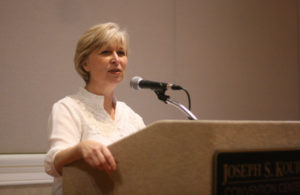Openness to calling a woman as senior pastor is growing incrementally in moderate and progressive Baptist churches in the southern United States, according to the latest State of Women in Baptist Life report by Baptist Women in Ministry.
“The statistics indicate that there is increasing affirmation of women’s gifts, growing willingness to call women as pastors and a rising commitment to gender equality,” said an updated report revised in July. “While there is yet much work to be done, the Baptist landscape is indeed changing, slowly but surely.”
Pam Durso, executive director of Baptist Women in Ministry, described 2015 as “a banner year for us,” with many women finding placement in their ministerial calling.
“The reality is women are being called at a faster pace than they were the years before 2005,” Durso said in a breakout session introducing the report at the recent Cooperative Baptist Fellowship General Assembly in Greensboro, N.C. “There is progress that is happening. It is slow, but it is happening.”
The 2015 State of Women in Baptist Life, the fifth in a series introduced in 2005, said giftedness and calling do not necessarily guarantee Baptist women a place to serve. “Some women endure great heartache because of an extended search process and the relentless rejection they encounter via letters and emails,” Durso said in an introduction co-written with BWIM intern Kevin Pranoto.
Durso said the unmarried face a particularly uphill battle. “It is challenging for a single woman to find calling as a Baptist pastor,” she said.
She described church planting as an under-utilized front door for women seeking to step into ministry leadership. “We need women who can start churches,” Durso said.
Since the 1964 ordination of Addie Davis as the first Southern Baptist woman ordained to the gospel ministry, BWIM counted 2,433 women’s ordinations through the end of 2015. The vast majority serve in ministry roles subservient to senior pastor.
In 2015, BWIM counted 174 women who were serving as pastor or co-pastor of a church affiliated with the Alliance of Baptists, Cooperative Baptist Fellowship or Baptist state conventions in Virginia, Texas and the District of Columbia, a 71 percent increase over the last 10 years. The study excludes American Baptist Churches, USA, because that denomination includes gender in its own record keeping.
One of the most common paths to service for Baptist clergywomen is chaplaincy and pastoral counseling. In 2015 nearly a third of chaplains endorsed by the CBF, Alliance and BGCT were women.
The percentage of female students at CBF-partner seminaries and divinity schools increased from 38 percent in 2010 to 44 percent in 2015, well ahead of the 33 percent average women student population in schools accredited by the Association of Theological Schools.
“We are training these women. What are we doing to help place these women?” Durso asked.
While many women hitting the stained-glass ceiling while seeking a ministry position feel little has changed, the report said the latest statistics “reflect a greater openness to women ministers within the moderate-to-progressive Baptist churches, denominations and institutions.”

